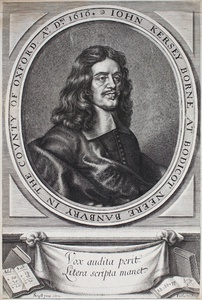| Method | Copper engraving |
| Artist | William Faithorne after Gilbert Soest |
| Published | [c. 1673] |
| Dimensions | Image 254 x 170 mm, Sheet 260 x 177 mm |
| Notes |
A bust portrait of John Kersey, turned to the right, wearing a doublet with lace collar and a luxurious cloak. The portrait is framed in oval border, with mathematical books and Kersey's motto on a curtained banderole in the bottom margin. Frontispiece to Kersey's "The Elements of that Mathematical Art Commonly Called Algebra", first published in London by William Godbid for Thomas Passinger and Benjamin Hurlock in 1673. Inscription to curtain below portrait: "Vox audita perit. Litera scripta manet", translates to: "What is spoken vanishes from remembrance. Only what is written remains" John Kersey (1616-1677) was an English mathematician, best known for his book "The Elements of that Mathematical Art Commonly Called Algebra", published in 1673-1674 in two volumes. William Faithorne (c. 1620-1691) was an English engraver and draughtsman. He apprenticed first to painter and printseller Robert Peake and later to engraver John Payne. Faithorne was imprisoned and then exiled as a royalist during the Civil Wars. By 1652 however, he had returned to London and able to establish his own print shop, thanks to his close links with the international print trade. In addition to selling prints, he continued to work as a printer and engraver, and published "The Art of Graving and Etching in 1662". On the Restoration of the monarchy in 1660, Faithorne was appointed copper engraver to the king. One of his sons, also named William Faithorne, became a mezzotint engraver. Gerard or Gilbert Soest (c. 1600-1680) was born in Soest, probably the town near Utrecht, but sometimes thought to be Soest in Germany. He probably trained in the Netherlands and worked there before he moved to London in 1644. Soest was a portrait painter, who was very successful, but his realistic style was not appreciated by many of the women he painted who felt their portraits were not flattering enough. O'Donoghue 1. This is the third state of the print, with the triangle at the bottom right in reverse and full stops added to the motto. Condition: Strong impression. Time toning, mainly to the corners of the sheet. Trimmed within plate mark and tipped to album page. |
| Framing | unmounted |
| Price | £150.00 |
| Stock ID | 46042 |

